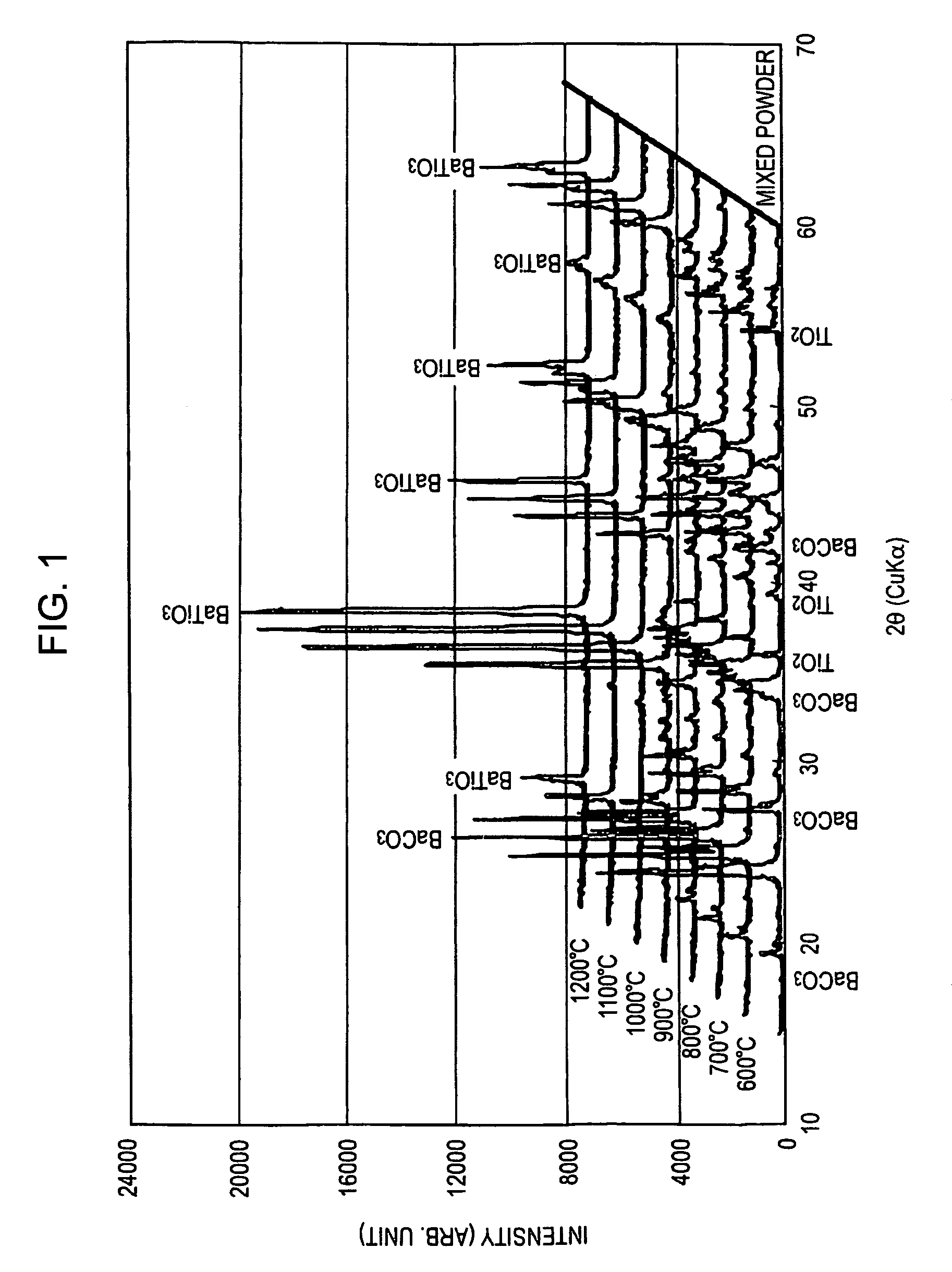Semiconductor ceramic composition and method for producing the same
a technology of semiconductor ceramics and compositions, applied in the direction of conductive materials, alkaline earth titanates, fixed capacitors, etc., can solve the problems of increasing the resistance at room temperature, increasing the temperature fluctuation near the curie temperature, and difficult to achieve stable room temperature resistivity and excellent jump characteristics, so as to prevent the compositional shift of bi—na, the effect of high jump characteristi
- Summary
- Abstract
- Description
- Claims
- Application Information
AI Technical Summary
Benefits of technology
Problems solved by technology
Method used
Image
Examples
example 1
[0068]Raw material powders of BaCO3, TiO2, and La2O3 were so blended as to satisfy (Ba0.994La0.006)TiO3, followed by mixing with a pure water. The thus-obtained mixed raw material powder was calcined at 500° C. to 1300° C. for 4 hours in the atmosphere to prepare (BaLa)TiO3 calcined powders. Shown in FIG. 1 are X-ray diffraction patterns of the thus-obtained (BaLa)TiO3 calcined powders at each of calcination temperatures from 500° C. to 1200° C. Note that the lowermost X-ray diffraction pattern is for the case of 500° C. temperature indication though any temperature indication is not given thereto.
[0069]Raw material powders of Na2CO3, Bi2O3, and TiO2 were so blended as to satisfy (Bi0.5Na0.5)TiO3, followed by mixing in ethanol. The thus-obtained mixed raw material powder was calcined at 800° C. for 2 hours in the atmosphere to obtain a (BiNa)TiO3 calcined powder.
[0070]Each of the (BaLa)TiO3 calcined powders and the (BiNa)TiO3 calcined powder prepared as described above were blended ...
example 2
[0074]Sintered materials were obtained in the same manner as in the sample number 13 of Example 1 except for adding SiO2 and CaCO3 in the amounts shown in Table 2 when blending the (BaLa)TiO3 calcined powder and the (BiNa)TiO3 calcined powder at the molar ratio of 73 / 7. A measurement of a temperature change of a resistivity value in each of the thus-obtained sintered materials was performed in the same manner as in Example 1. The measurement results are shown in Table 2. As is apparent from Table 2, by the addition of the Si oxide and the Ca carbonate or the Ca oxide during the steps, a high jump characteristic is achieved, and an increase in room temperature resistivity is suppressed as in Example 1.
example 3
[0075]Raw material powders of BaCO3 and TiO2 used as main ingredients and Nb2O5 as a semiconductive dopant were blended so as to satisfy Ba(Ti0.998Nb0.002)O3, followed by mixing with a pure water. The thus-obtained mixed raw material powder was calcined in the atmosphere at 700° C. to 900° C. for 4 hours to prepare Ba(TiNb)O3 calcined powders. In the thus-obtained Ba(TiNb)O3 calcined powders, Ba(TiNb)O3 was not perfectly formed, and BaCO3 and TiO2 were remained therein.
[0076]Raw material powders of NaCO3, Bi2O3, and TiO2 were blended so as to satisfy (Bi0.5Na0.5)TiO3, followed by mixing in ethanol. The thus-obtained mixed raw material powder was calcined at 800° C. for 2 hours in the atmosphere to prepare (BiNa)TiO3 calcined powders.
[0077]Sintered materials were obtained in the same manner as in Example 1 by blending each of the Ba(TiNb)O3 calcined powders and the (BiNa)TiO3 calcined powder prepared as described above at a molar ratio of 73 / 7. A measurement of a temperature change o...
PUM
| Property | Measurement | Unit |
|---|---|---|
| temperature | aaaaa | aaaaa |
| temperature | aaaaa | aaaaa |
| Curie temperatures | aaaaa | aaaaa |
Abstract
Description
Claims
Application Information
 Login to View More
Login to View More - R&D
- Intellectual Property
- Life Sciences
- Materials
- Tech Scout
- Unparalleled Data Quality
- Higher Quality Content
- 60% Fewer Hallucinations
Browse by: Latest US Patents, China's latest patents, Technical Efficacy Thesaurus, Application Domain, Technology Topic, Popular Technical Reports.
© 2025 PatSnap. All rights reserved.Legal|Privacy policy|Modern Slavery Act Transparency Statement|Sitemap|About US| Contact US: help@patsnap.com


